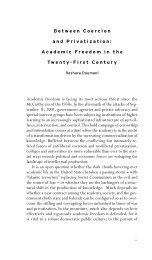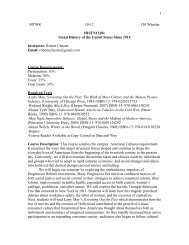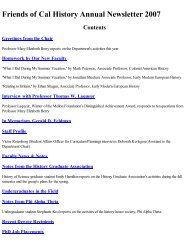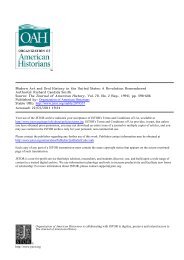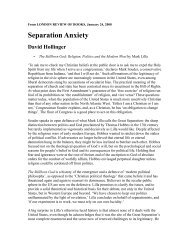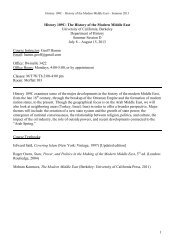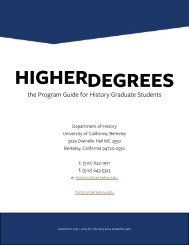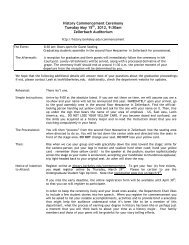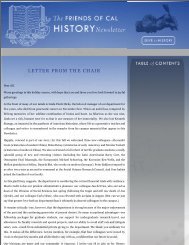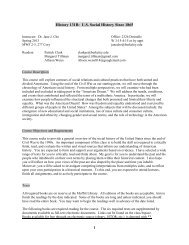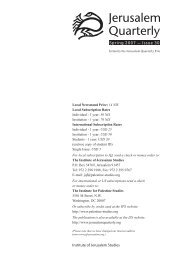David A. Hollinger | Amalgamation and Hypodescent: The Question ...
David A. Hollinger | Amalgamation and Hypodescent: The Question ...
David A. Hollinger | Amalgamation and Hypodescent: The Question ...
Create successful ePaper yourself
Turn your PDF publications into a flip-book with our unique Google optimized e-Paper software.
Explorations of Interracial Literature (New York, 1997).31 Ê A discerning study of the sociology of the new "multiracial movement" is Kim Williams, "From Civil Rights to the MultiracialMovement," in Winters <strong>and</strong> DeBose, New Faces, 85–98.32 Ê For an exceptionally clear <strong>and</strong> fair-minded analysis of the concept of "race" in the American historical context, see LawrenceBlum, "I'm Not a Racist, But ... " (Ithaca, N.Y., 2002). For a helpful sampling of recent theoretical writings on this concept, seeBernard Boxill, ed., Race <strong>and</strong> Racism (Oxford, 2001), especially Boxill's introduction, 1–41, <strong>and</strong> the opening essay by Naomi Zack,"Race <strong>and</strong> Philosophic Meaning," 43–82. See also Naomi Zack, ed., American Mixed Race: <strong>The</strong> Culture of Microdiversity (Lanham,Md., 1995).33 Ê James McBride, <strong>The</strong> Color of Water (New York, 1999); Shirlee Taylor Haizlip, <strong>The</strong> Sweeter the Juice (New York, 1994); seealso Paul Spickard, "<strong>The</strong> Subject Is Mixed Race: <strong>The</strong> Boom in Biracial Biography," in Parker <strong>and</strong> Song, Rethinking "Mixed Race,"76–98. Spickard addresses more than three dozen biographies <strong>and</strong> memoirs published in the United States in the 1990s. He alsoengages critically (80–81) one of the most widely read essays of the 1990s on ethnoracial mixture <strong>and</strong> the one-drop rule, HenryLouis Gates, Jr., "White Like Me," New Yorker (June 17, 1996): 66–81, an analysis of the life of "black" writer Anatole Broyard,who passed as white.34 Ê Philip Roth, <strong>The</strong> Human Stain (New York, 2000). But while Twain allowed the "black" character growing up as white to displaydisturbing behaviors that played to his reader's suspicions that "black blood" might carry negative propensities, Roth embraced his"black" character in what was, for Roth, the ultimate psychological <strong>and</strong> cultural solidarity: Roth endowed Coleman Silk with thepersona Roth had developed affectionately in novel after novel over the course of thirty-five years, the persona of the neuroticJewish intellectual. Midway between Twain <strong>and</strong> Roth, chronologically, another prominent white novelist addressed the theme, butSinclair Lewis's Kingsblood Royal (New York, 1947) offered white readers few of the concessions Twain did, was covered by noneof the conventions of humor that gave Twain great license for dealing with sensitive topics, <strong>and</strong> was too deeply radical in its critiqueof racism <strong>and</strong> of the one-drop rule to generate a positive response from a white readership in the 1940s.35 Ê <strong>The</strong> most prominent organizations include the Association of MultiEthnic Americans <strong>and</strong> Project RACE (Reclassify AllChildren Equally); http://www.webcom/intvoice is the web site for another such organization, "Interracial Voice." One scholar hascounted more than eighty multi-racial organizations established in the United States since 1979; see Williams, "From Civil Rights tothe Multiracial Movement," 93. Two volumes of the 1990s that advanced public awareness of this movement were edited by apresident of the Association of MultiEthnic Americans: M. M. Root, ed., Racially Mixed People in America (Thous<strong>and</strong> Oaks, Calif.,1992); Root, ed., <strong>The</strong> Multiracial Experience (Newbury Park, Calif., 1996).36 Ê For a thorough, scholarly review of the evidence, see Joseph J. Ellis, "Jefferson: Post-DNA," William <strong>and</strong> Mary Quarterly, 3dser., 57 (2000): 125–38.37 Ê Woods stimulated extensive public discussion of the one-drop rule in 1997 when he told talk-show host Oprah Winfrey onnational television that he was not comfortable being labeled "black," <strong>and</strong> sometimes thought of himself as a "Cablinasian," a labelmade up of fragments of "Caucasian," "black," "Indian," <strong>and</strong> "Asian." For an informative discussion of the controversy surroundingWoods, see Henry Yu, "How Tiger Woods Lost His Stripes," in John Carlos Rowe, ed., Post-Nationalist American Studies(Berkeley, Calif., 2000), 223–46.38 Ê <strong>The</strong> convention of representing non-Anglo ancestry as disproportionately female is often noted in the literature on ethnoracialmixtures. See, for example, Bethany Ruth Berger, "After Pocahontas: Indian Women <strong>and</strong> the Law, 1830–1934," American IndianLaw Review 1 (1997), rpt. in Johnson, Mixed Race, 71–80.39 Ê For a memoir of a "black" person who questioned hypodescent only after encountering the mestizaje associated with Latinos, seeRanier Spencer, "Race <strong>and</strong> Mixed-Race: A Personal Tour," in William S. Penn, ed., As We Are Now: Mixblood Essays on Race <strong>and</strong>Identity (Berkeley, Calif., 1997), 126–39, esp. 134–35.40 Ê <strong>The</strong> law had been modified in 1870 to provide for the naturalization of persons of African descent, but the bar to thenaturalization of immigrants from Asia had been mitigated only by the 1943 provision of an annual quota of 105 Chinese immigrantsattendant upon the repeal in that year of the Chinese Exclusion Act.41 Ê Pascoe, "Miscegenation Law," 49, notes that fourteen states had included Asian Americans, under a variety of labels, at one timeor another, <strong>and</strong> that nine did the same with "Maylays," the term long in use for Filipinos.



